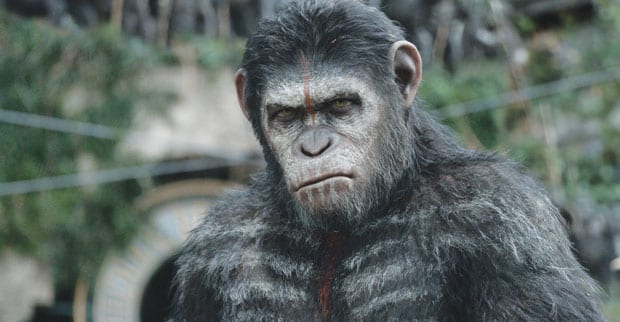All hail Caesar in ‘Dawn of the Apes;’ animal magnetism sputters in ‘Fur’

SIMIAN RIVALRY | Although computer-assisted, Andy Serkis’ performance as chimp leader Caesar in ‘Dawn of the Planet of the Apes’ grounds the sci-fi extravaganza as a thoughtful reverie on war.
ARNOLD WAYNE JONES | Executive Editor
 It doesn’t take much more than 10 minutes of Dawn of the Planet of the Apes before you stop thinking, “Wow! What awesome special effects!” and start thinking, “These apes sure are good actors.” Of course, they aren’t apes … and yet they are. These aren’t wholly CGI-created fictions but performers, led by Andy Serkis, in motion-capture technology that not only tracks body movement but detailed facial movements. The result is an amazing illusion, which allows the audience to relate to the simians as real beings. And that leaves a lot of ambiguity in the message of Planet of the Apes we’ve held for 45 years.
It doesn’t take much more than 10 minutes of Dawn of the Planet of the Apes before you stop thinking, “Wow! What awesome special effects!” and start thinking, “These apes sure are good actors.” Of course, they aren’t apes … and yet they are. These aren’t wholly CGI-created fictions but performers, led by Andy Serkis, in motion-capture technology that not only tracks body movement but detailed facial movements. The result is an amazing illusion, which allows the audience to relate to the simians as real beings. And that leaves a lot of ambiguity in the message of Planet of the Apes we’ve held for 45 years.
The original 1968 film was a classic of the sci-fi genre in the post-atomic age. The mysterious “planet” was Earth, hundreds of years in the future, after mankind blew it up and a new set of primates, with Darwinian determination, rose up as the dominant species, turning the remnants of the human race into its pets. The latter-day prequels — 2011’s Rise of the Planet of the Apes and now this — pose a different twist, suggesting it wasn’t nuclear winter but a man-made pathogen that led to humanity’s downfall.
Ultimately, the reason we were replaced doesn’t matter. The real question asked, back in the ’60s and today, is: “What can we do to stop it?” And the answer in Dawn seems to be: “Man doesn’t deserve the planet anymore.” We’re the dinosaurs, and we have only ourselves to blame.
If that sounds waaaay too serious for a summer action movie, well, you need to pay attention to Dawn, one of the smartest and most contemplative tent-pole franchise entries Hollywood has recently produced. There’s tons of action, but even more dialogue … and even more careful plotting.
Caesar (Serkis), the missing-link chimp whose intelligence marked a paradigm shift in evolution, is the undisputed leader of the ape world, which lives peacefully away from humans in the forests of North California. The ragtag human survivors in San Francisco need access to a hydroelectric damn in Caesar’s kingdom to keep from dying out. Can they reach a détente that will allow peaceful coexistence? Will Koba, Caesar’s warmongering consigilere, or Dreyfus (Gary Oldman), the suspicious human, foment conflict until it’s too late?
Director Matt Reeves has fashioned a post-apocalyptic parable that recalls modern-day conflicts, from rallying political support via demonization of the enemy to assassination as an excuse for war to, sadly, the impossibility of having real principles — it’s Camelot, with less singing and more gorillas.
The cast sells it. The human actors, especially Jason Clarke, never wink at the audience and just how they interact with the half-actor, half-digital apes will leave you scratching your head … or under your arms. Serkis may finally get a long-overdue Oscar nomination for one of his enhanced performances. His haunting eyes make Dawn a crowd-pleaser you won’t soon shake.
 The fur flies in Dawn, but it gets caressed, stroked and eroticized in Venus in Fur, Roman Polanski’s film adaptation of David Ives’ Broadway two-hander about an actress named Vanda (Emmanuelle Seigner) whose audition for a nebbishy playwright (Mathieu Amalric) takes on a sexually charged energy. Is the actress — who wants to play a character also named Vanda — real, or a figment of his imagination? Is that dialogue she’s speaking or some kind of improvised mind-screw?
The fur flies in Dawn, but it gets caressed, stroked and eroticized in Venus in Fur, Roman Polanski’s film adaptation of David Ives’ Broadway two-hander about an actress named Vanda (Emmanuelle Seigner) whose audition for a nebbishy playwright (Mathieu Amalric) takes on a sexually charged energy. Is the actress — who wants to play a character also named Vanda — real, or a figment of his imagination? Is that dialogue she’s speaking or some kind of improvised mind-screw?
Venus in Fur marks the 80-year-old director’s second consecutive foray into film versions of small-bore stage works (following 2011’s Carnage) and he seems to revel in contradictions: Carnage was based on a play written in French but filmed in English, and Venus is the opposite.
Why? Maybe because the subject matter — a brooding author obsessed with adapting the book that gave us the term “sado-masochism,” who himself was deeply affected by the pleasure-pain principle — is oddly close to Polanski’s heart. (Amalric is even a dead-ringer for the young Roman.) Sex dramas somehow seem more European, especially when they enter the woozy netherworld where fact merges with fantasy, as it does here.
That’s not aided by the fact Polanski doesn’t really open up the story beyond its stagy, one-set, one-act structure: In 90 minutes, you get the full range of this seesaw of dueling personalities, where power shifts from one to the other and words take on a prickly, seductive resonance. That’s better live than on film, especially in the real-time set up of Venus. Polanski, usually a master at psychosexual drama, stumbles through the imagery. It lacks the creepy passion he has touched on so disturbingly in the past.
Seigner (Polanski’s actual wife) should be too old for the part, but she carries it off with a pouty, earthy carnality. (She looks a lot like Christina Applegate.) Amalric has the thankless role of a kinky man easily manipulated by women. But their pas-de-deux ends up as a pas-de-don’t.
This article appeared in the Dallas Voice print edition July 11, 2014.












